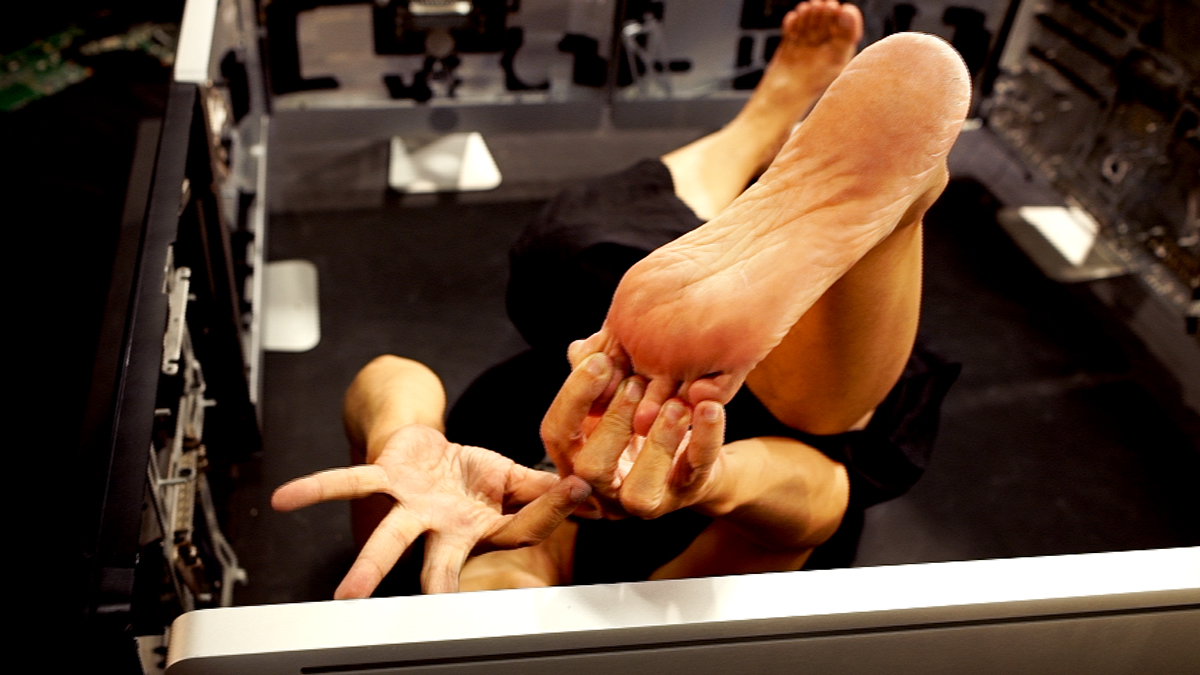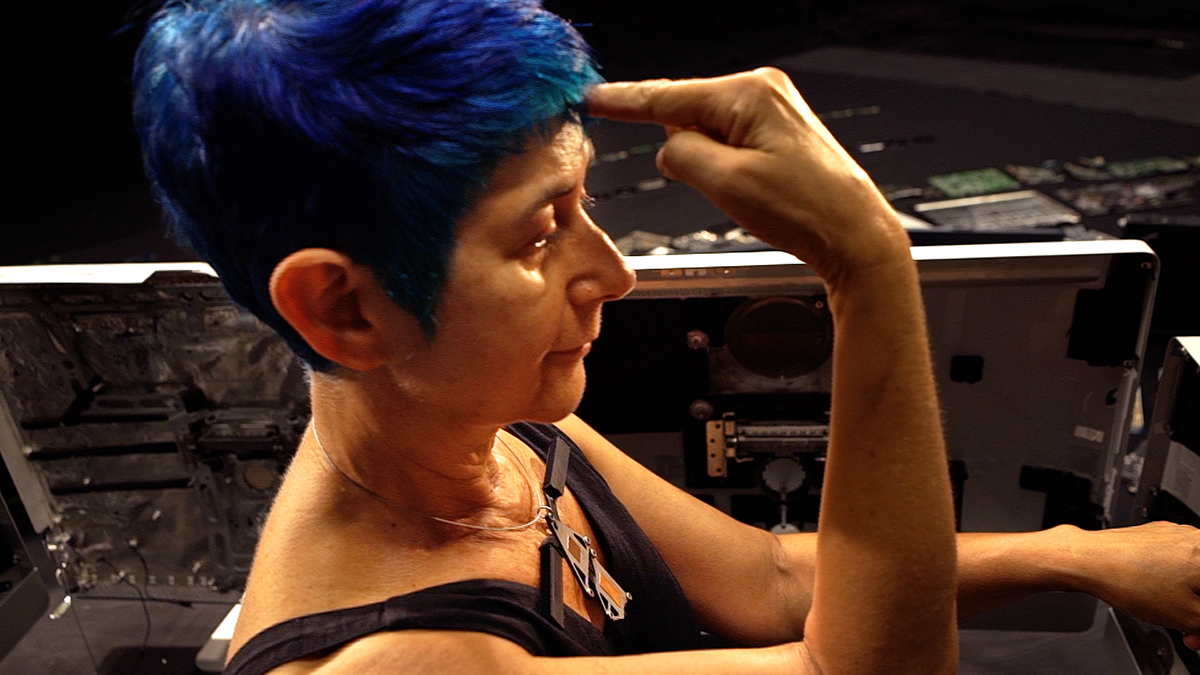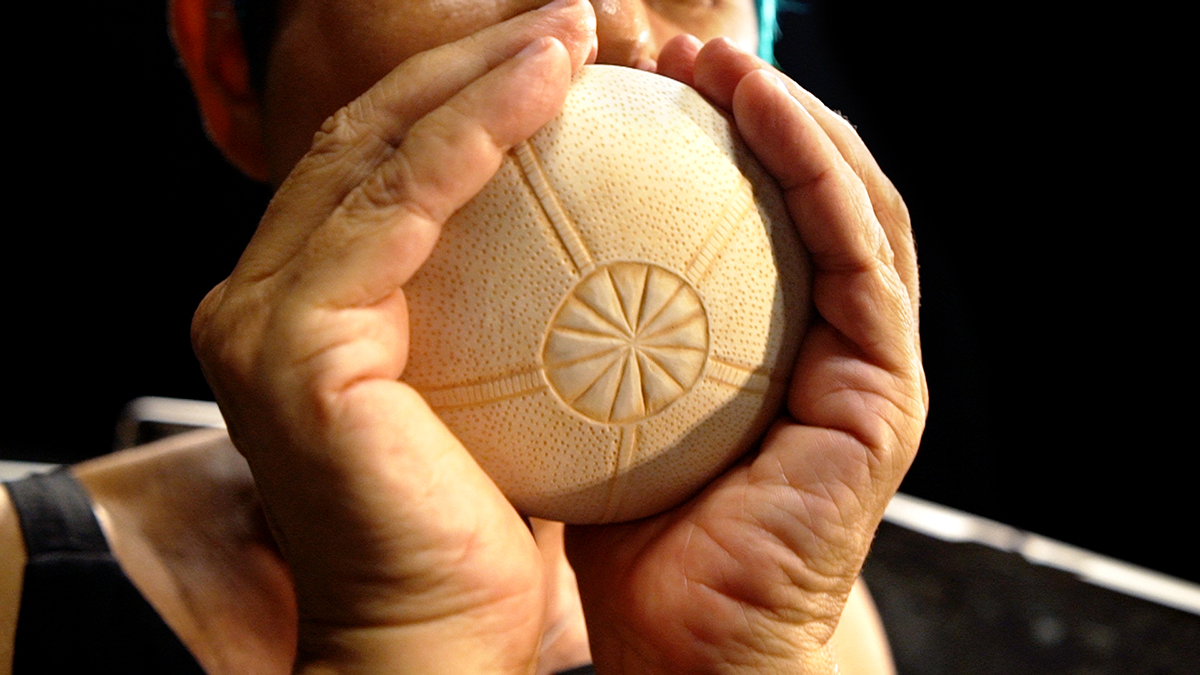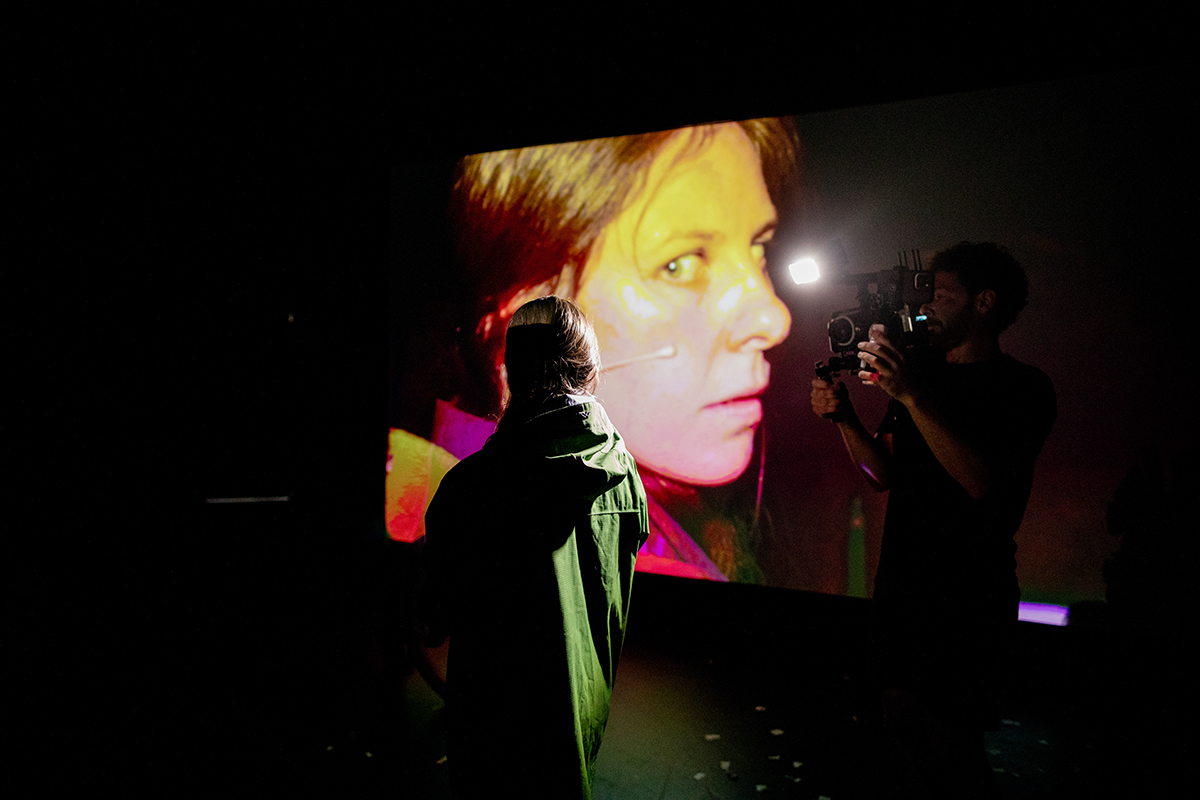March 2022
The viewer of Brisbane-based multidisciplinary artist Suzon Fuks’ Be Like Body—Obsolete #4 first experiences a sense of flight into a slow turning spiral, a galaxy perhaps, its starry tendrils curling out into deep, dark space. The poet Parvathy Baul (India) sings ethereally of a divine yogi in a cosmos where “Neither is there beginning nor is there end.” We arrive, not at the black hole of a galaxy, but a squared-off space in which a restless body writhing on its back seeks comfort in briefly achieved geometric formations. Up close the seeming stars are aged keyboards, motherboards, laptops, cables and hard drives — a Sargasso Sea-like swirling constellation of tech junk at the centre of which Fuks’ body is bounded by eight large computers minus their screens and electronics — blind technology. She touches them tentatively.
In what Fuks describes as “a poetic meditation on age, obsolescence and technology,” the artist enacts an existential crisis. Her ageing, isolated body is caged by computer detritus, useless but nonetheless symbolising her digital entrapment. Ironically it bespeaks the very same media that enables Fuks to express her condition with kindred female spirits, six writers scattered about the Earth inscribing in verse and voice in various languages their similar suffering — separation, invisibility, loss of both intimacy and a sense of being human — as well as offering consolations and incitements to resistance.
Fuks told me that she first created the video of her imprisoned self and sent it to the writers who, in turn, responded with poems that built on and expanded on it, adding new layers of metaphor and reflecting on their own states of being. Fuks has made the complete poems available on her website, both as an e-book and recordings, but for her performance edited the poems (and, in turn her video) to match and generate the rhythms and concerns of her performance. The voices we hear are those of the poets themselves, the words often also appearing onscreen in English and original language subtitles or sometimes circulating in patterns across the screen. After Fuks’ live welcome, the streamed performance comprises a pre-recorded first half, with its dramatic play with lines of sight and time, and a live second half, followed by interaction with the ‘zoomed’ audience in terms of the resonances felt in key words and sounds in the performance. I first saw the recorded version of the live stream in 2021 and took a fresh look at it recently, at its weave of image, metaphor, performance and filming.
The galaxy disappears. Sudden darkness, panic, a voice asking in Korean, “Hello, is there anyone there? Can you hear me? How did I get here?” Confirming the work’s opening galactic image, Younghee Park (South Korea) describes a plight of isolation and repetition, glimpsing millions of dots, dust perhaps, in which, grimly, “My endless footprints have become a cosmos in the middle of vast darkness.”
In close-up, Fuks, in a spare black garment and hair dyed a vivid blue, flares her fingers and pulls at her feet as if to undo cramping tension, while a Spanish speaker, Amaranta Osorio (Mexico), cries “Escape!”, joined by a chorus of voices in other languages. The artist springs into rapid animation-like motion against her confinement. The speaker is defiant, “Erase it all and start over.”
We draw closer to Fuks gently touching at the frame of an empty computer while Osorio yearns “to touch you again/ Feel the beat of your heart/ Travel your skins with my fingers./ That would ease my pain./ I feel like an autumn leaf, trodden on.” The poet laments the digital double bind, being “just one click away/ So close yet so far,” the technology that “erases borders and also locks me up … I’m just a human locked in an endless spiral.”
Annie Abrahams (France/Netherlands) intones with sad anger — “the world is made of dust/ computers are made of dust too …. Dangerous dust” — made more emphatic when expressed in Dutch as “stof.” Later in the performance, the poet will speak of exploited workers “harvesting the dust/ our machines require,” and of her own tired toiling, concluding powerfully: “don’t touch me/ I am an unstable system on the verge of…/ non-sense.”
The camera closes in on Fuks’ naked back — vulnerable, inevitably dust. She stands, gesturing as if in gentle supplication or graceful yogic meditation, balanced on one leg, blocking out perhaps Abrahams’ grim programming lingo in French and Dutch, the code simultaneously typed across the screen in English: “#include <old age.h> use experience std; style. display+“destroy” enum u (promise, desire, dust, grass, waste),”
Osorio returns, equating technology with extinction and bewailing “time that passes and no longer seems to pass, the present.” Fuks beats the computer-tops rhythmically with machine parts; a brief moment of order and release in an uncertain present. Skittering electronics accompany her as she morphs, insect-like, her hands, arms, torso vibrating while Osorio objects to a “Sea of information /Digital noise without pause/,” asking, “How to sing without music?” Fuks attacks the screens before collapsing on her back, hands and feet flailing: “I am just a human/ Locked in a spiral of footprints, of dots./ Everything turns to dust. I am dust.”
Fuks’ desperation again becomes action. Seemingly prompted by Abraham’s coded recitation of “resistance,” “soul,” “body” with an urging chorus of other voices, Fuks, fraught at first like a rat in a maze, pulls violently at the screens. But in a surprising switch she breathes forcefully into the centre of each. In a rapid shift of point of view, we’re inside the devices seeing Fuks’ mouth. Mouth-to-mouth for a dying technology or resuscitation for those of us digitally entrapped? She peers in at us.
In a significant change of mood, a seemingly calm Fuks blows dust from a keyboard and wipes it from a screen top. Her world is suddenly lighter, whiter and curiously transparent, the dark hues of the previous half of the performance evaporated. We watch, detached, from above as she casually sorts and gathers a variety of parts and then peers directly at us through a gap in a circuit board that masks and replaces the human face while Abrahams reinvokes the image of people, world and machines made of dust.
Fuks takes a bubble-wrapped parcel from one of the screens and opens it to reveal a book titled H U M A N, each letter a keycap taken from a keyboard. We hear “resist” spoken in multiple languages; it appears in Farsi, swelling to fill the screen. Fuks does not spring into action, instead she gently turns the pages of the book, touching indecipherable images, each made from keyboard circuits, while Nasim Khosravi (Iran) intones an ironic poem-cum-sermon in which “…we have emptied the oceans of water/ In search of Aabe-e-Hayat/ [Aab-e-Hayat is the elixir of immortality, water or life]/ And we are immortalised in the microchip neighbourhoods of integrated circuits in countless layers of shatterproof screens. … Oh Human, Take refuge in Google, the only way to salvation…” However, the poet’s mother tells her daughter, “artificial intelligence does not understand human suffering. It does not understand love.” In the touching complete poem, available in the performance’s accompanying e-book, the mother with her too lately granted titanium knees, “laughs and says: Robots do not say, ‘Though I be old, tonight embrace me tightly’.”
The letters on the final pages of the book spell out “vulnerable.” As the camera draws tightly close on her face for the first time, Fuks removes the circuit board, gazes at us and says, “Human.” It’s a quiet declaration of survival.
Fuks’ calm ensues. Her mood is contemplative, evincing an almost everyday sense of ease. She scrolls messages on her phone while Ya-Ling Peng (Taiwan) muses over ageing and obsolescence and turns to Buddha for comfort. Wearing a necklace she’s made of computer parts, Fuks makes another and dons improvised earrings (the artist makes such jewellery as part of her practice). She picks up and listens to what appears to be a shell (Fuks tells me “It’s a ceramic that reminds me of a sea urchin fossil or a conch”) as Amaranta Osorio despairingly conjures up a “Sea of information/ Every second a death/ Virus, inequality, poverty, violence/ (in which) I can’t do anything.”
Fuks, however, now in dream-like colour negative, acts. She breathes deeply into her palms, opens them and pushes her breath out into the world, instead of into dead computers, a symbolic act of sharing and compassion. Osorio concurs, “I need to stop/ Let my heart beat in a shell/ Be free, for even a moment./ To breathe. Forget about me.”
In Be Like Body—Obsolete #4’s final scene, the screen becomes two overlapping spaces. One, in black and white has Fuks half curled on the floor, breathing into the shell; in the other (in negative colour) she leans back to rest within her square, cupping the shell, and almost disappearing as her image shrinks. But she returns, resuscitated by the poet’s “Hold on for a moment/ one second/ make a pause/ Listen to the silence.” With the ceramic at her belly, her arms symmetrically framing her torso and the soles of her feet meeting, Fuks appears in the end to achieve a kind of yogic grace: “And there, life.”
The performer still resides within the wall of screens and the spiral of technological decay, but, as Fuks has written of her intended persona in the first stage of the work’s development, she “is also the living centre of this spiral structure, elder and guardian. Her humanity contrasts with the metallic/electronic technology through dance, touch, nurture, affection, curiosity and ceremony.”
The engaging voices of her poet collaborators implicitly offer comfort and community. Although she doesn’t engage with them directly in the performance, she mirrors their concerns and appears at times to act on their encouragement. They resonate as part of her consciousness as well as becoming members of a collective multilingual one. Fuks has written that she wanted “to highlight the wealth of various cultures online, promoting acceptance and making space online for culture and language inclusivity, destabilising the primacy of English.”
I first saw Be Like Body Obsolete #4 in 2021. Watching it again recently confirmed my enjoyment of Fuks’ image-making (she’s an experienced filmmaker), achieved with modest but effective technical means and emotional and dramatic resonance with the words of her writer collaborators. The alternation between choreographed movement sequences — entailing deft editing, superimposition and various camera points of view (videographer Freddy Komp) — and a live art sense of informality of the artist/persona at work in real time, is particularly effective. It’s no easy task to express a despairing sense of isolation and invisibility and then convincingly find psychological equanimity and serenity while still spatially trapped in what looks like a post-apocalyptic galaxy. The work speaks to the need to develop individual, internal strategies for survival in oppressive times, and although Suzon Fuks’ persona remains alone, the sense of her embodying the words and spirit of her collaborators, with compassion, grants at least some sense of optimism.
***
See Be Like Body — Obsolete#4 on Vimeo here. It was documented from an online broadcast, Sunday 27 June 2021 at Vulcana Circus, Brisbane as part of Bodies:On:Live Magdalena:On:Line 2021, a Magdelena Project festival, 24-27 June, 2021.
The performance concludes at the 26’50” mark. Afterwards there’s an online response from the audience. I saw the recording of Be Like Body — Obsolete#4, not the original streaming of it, so was not part of the sharing of responses between the artist and her ‘zoomed’ audience. Fuks sees the live discussion, focused on the words and sounds the audience responded to, as an integral part of her performance.
An hour-long Artists’ Talk can be found here. A very good adjunct to the performance is the e-book of the poems and a set of audio recordings with onscreen translations of the writers reading their poems. The work was also broadcast as part of the Festival Mestiza, Chile, 26 September, 2021.
Read about Brisbane-based, Brussels-born Suzon Fuks and see more of her works on her website https://suzonfuks.net/.
From the Archive: RealTime on works by Suzon Fuks and others made in collaboration with James Cunningham
FLUIDATA, RealTime 126, April-May 2015
Waterwheel, RealTime 104, Aug-Sept 2011
Fragmentation, RealTime 86, Aug-Sept 2008
Mirage, RealTime, Feb-March 2007
Thanatonauts, Navigators of Death, RealTime 61, June-July 2004
The Hands Project, RealTime 41, Feb-March 2001
The Vinildas Gurrukal Masterclass, RealTime 46, Dec-Jan 2001
Body in Question, RealTime 33, Oct-Nov 1999
—
Suzon Fuks, Be Like Body — Obsolete#4, The Magdelena Online Festival, performer, project initiator Suzon Fuks; writers Amaranta Osorio (Mexico), Annie Abrahams (France/Netherlands), Nasim Khosravi (Iran), Parvathy Baul (India), Ya-Ling Peng (Taiwan), Younghee Park (Korea); outside eye James Cunningham; videographer/technical manager Freddy Komp (Australia); Vulcana Circus, Brisbane, 27 June, 2021
Top image credit: Suzon Fuks, Be Like Body—Obsolete #4, photo Suzon Fuks
re:group’s live-cinema event COIL is an astonishingly multi-layered, funny-sad eulogy for, among other things, the demise of video rental stores around Australia, including the wonderful Film Club in Sydney’s Darlinghurst, which closed March 14. The audience for COIL at Sydney’s PACT in February groaned at mention of the imminent loss.
A “multi-layered eulogy” because the store closures are the foundation in COIL on which other grievings are built: for the diminution of a Wollongong University graduate performance collective from 15 to three members over a decade and some seven productions; for the loss of a pivotal creative bro-mance; for not making a promised film which is reduced to an hilariously inadequate trailer, miraculously manufactured before our eyes by a mere trio of maker-performers; and for the failure of another personal relationship, which that trailer symbolises.
Yes, it’s complex, even metaphysical, as suggested by the title COIL which is embodied in the work’s marvellous play with looping time and recollection. And it’s critical — of commercial streaming’s narrowing of creativity and access. The more content, the more choice promised by streaming services comes at a growing subscription expense and cultural cost with rarer, often even major films ever disappearing from our reach.
Film Club had an enormous inventory of arthouse films from many nations alongside commercial fare, cult films, classic silent movies and, not least, says COIL, “weird movies.” There’s small respite for cinephiles with access to MUBI, but little sign of the Criterion Channel becoming available in Australia. Anyway, these can’t replace the sheer range of choice and the sense of community often engendered by video stores — commercial businesses serving the common good.
This irony is underlined when COIL’s host, Steve Wilson-Alexander, recalls a woman who on seeing the closed video store (where Wilson-Alexander worked) in scaffolding, angrily demands,” Why weren’t we told about this? It’s a public building!” (It wasn’t) He imagines his passionate retort, “I thought…When was the last time you went here? To your local bookshop, record shop, the theatre, a gig? You did this, lady! … We’ll sacrifice anything for the sake of ease. I do it without thinking, with a click.”
The major player in COIL, Wilson-Alexander rapidly alternates between frankly confessional host, video store employee, the Thirroul store’s owners (for 38 years), customers, a cocky tradie measuring the space as a prelude to knocking down walls and a child wanting a lolly snake: “What film do you like best?” asks Wilson-Alexander. “YouTube,” replies the kid. Then there are the sci-fi/horror grotesques Wilson-Alexander realises for the trailer.
The performer dextrously role-switches with remarkable speed, while Solomon Thomas, in black, hovers close about him with camera, issuing instructions, shooting with unruffled ease live-to-screen images and recording numerous snippets of action that will add up to the trailer of the promised film. The latter takes, startlingly brief and without introduction, often make no immediate sense but are hilariously instructive about filmmaking craft, its cliches and, for the knowing, references to an array of films. Carly Young, working at a bank of computers to the side, steps onstage to facilitate the shooting of brief episodes (including catching a stream of tossed DVD cases) before playing herself, the writer of the COIL screenplay that Wilson-Alexander promised to film.
All of this is realised in a highly effective facsimile of a video shop, replete with the actual store sign rescued from Video Edge where Wilson-Alexander had once worked. A large screen extending the set to the left allows audience and performers to simultaneously view live and screen action in close juxtaposition. The handling of the DVDs, the stacking, displaying, the favourites held up to camera (along with litanies of personal preferences and dislikes) and one DVD sleeve with a spooky life of its own, evoke a deep sense of familiarity with the tedium and weirdness of video store life, executed with great humour — slapstick, sight gags, screen jokes and wit.
Fun aside, COIL is a serious reflection on loss. Through a weave of anecdotes, store scenes and trailer takes, writer Mark Rogers ingeniously threads Wilson-Alexander’s recollections of his personal and creative friendship with former company member and, implicitly, re:group artistic director Jackson Davis, who left to train as a nurse in Hobart and is now rarely in contact, let alone seen. Wilson-Alexander repeatedly loops back to the relationship, how the pair made their first films in high school, cycled to video shops from Wollongong to Thirroul, and playfully argued over which film directors were best. Wilson-Alexander’s recurring lament is a closed loop, analogously the coil of Young’s time travel screenplay. Wilson-Alexander asks her, “Is the main character the guy who goes back in time or the future version of him? … What does that even mean? … I think your time travel mechanics might need some work.” So might his.
Prior to the screening of the trailer, there’s a surprising shift in tone: a poignant, finely played reckoning of the relationship other than with Davis, between Carly Young and Wilson-Alexander — another in which Wilson-Alexander’s fixation on the past undoes him. It’s a melancholy but a perfect reveal of an underlying sadness. The trailer is as hilarious as we expected it to be, but for Young, sombrely declaring: “It made me kind of sad. Watching it’s like being back there. But we’re not.”
Of course, I’m curious. Are these ‘characters’ the real Carly Young and Steve Wilson-Alexander, or Wilson-Alexander’s projections, or performer personae, the versions of themselves they’re happy to offer writer-confidante Mark Rogers and us for their art, for some greater good? We’re not to know, but being granted insights, largely comedically played, into these artists’ lives — creative and personal and their intertwining — is one of COIL’s key pleasures. This is especially so when the sense of personal loss is coiled within an overarching eulogy for video stores — not the performance spaces and opera houses we associate with culture, but just as subject to the predations of commerce and a diminishing sense of the common good.
COIL is the product of a remarkable collective effort, evident in the tightly synchronised interplay of live and screened action, in Solomon Thomas and Steve Wilson-Alexander’s camera-performer duet danced across every inch and angle of the video store, in Wilson-Alexander and Carly Young’s quiet moment of truth-telling, and in the extreme character gearshifts, physical and vocal, demanded of Wilson-Alexander by this group-realised creation, including Mark Rogers’ deft live cinema screenplay, in which the present is always coiling back into past.
COIL will enjoy another Sydney season, 8-11 June, at the Sydney Opera House as part of the house’s innovative UnWrapped program.
re:group before
Among COIL’s wonderful precursors was Lovely, one of my favourite performance experiences of the last decade, a seamlessly choreographed interplay of live camera work and performance in a loving attempt to call back Philip Seymour Hoffman from the dead, which I reviewed in “Loving Philip Seymour Hoffman” (RT125, Feb-March 2015). Nikki Heywood’s response in “Homemade space travel” (25 October 2017, RealTime online), to Route Dash Niner: Part II captures re:group’s genius at making a spectacular and meaningful low-budget live sci-fi movie.
In an interview with RealTime in 2017, “Jackson Davis: The art of videographic performance” (RealTime online 21 November 2017), Davis gave a fascinating account of the collective’s workings and inspirations. Since its inception in 1994, RealTime documented the growth of the interplay of live camera feed and performance, not least in dance, by dedicated innovators working on the cultural margins. Mainstream theatre has finally caught up, often on a grand scale, sometimes at the expense of the live body made ridiculously small against its screen self. Not so re:group’s finely honed, intimate balance of performer and image.
—
re:group performance collective, COIL, Steve Wilson-Alexander, Solomon Thomas, Carly Young, video design Solomon Thomas, screenplay Mark Rogers, automation programming Chris Howell, sound design Liam ‘Snowy’ Halliwell, creative producer Malcolm Whittaker, set realisation Alistair Davies; PACT Theatre, Sydney, 10-12 Feb;
Top image credit: Lucy Parakhina







